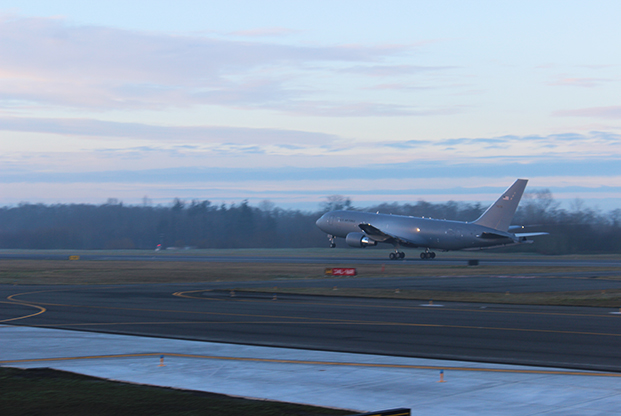
A KC-46 takes off Friday morning from Boeing's production facility in Everett, Wash., on a delivery flight to McConnell AFB, Kan., for the first time. Staff photo by Brian Everstine
EVERETT, Wash.—The Air Force began its next era of aerial refueling on Friday, as the first two KC-46s left their production facility here and landed at McConnell AFB, Kan., to begin service.
The tankers, tail numbers 15-6009 and 17-6031, left Boeing’s production facility in Everett, Wash., on a cold and foggy morning, with a KC-135 from McConnell leading the way. The two aircraft touched down in the afternoon. During a ceremony at the base the same day, Air Force Chief of Staff Gen. David Goldfein said the arrival of the aircraft marked a “new era” of refueling.
“Let me say thank you for all the US and coalition saves in your future as you bring this KC-46 weapons system to full operational capability,” Goldfein told the audience at McConnell. “We’re a global power because of global reach. Our allies count on it, and our adversaries know it.”
The first aircraft carried USAF and Boeing VIPs, including Air Force Secretary Heather Wilson, Air Mobility Command boss Gen. Maryanne Miller, and Boeing Defense CEO Leanne Caret. Hundreds of airmen filled a new hangar at the Kansas base to welcome the aircraft.
The handover of the two planes kicks off USAF training with the aircraft, along with operational test and evaluation.
“Today the KC-46 Pegasus joins a proud history here at McConnell Air Force Base,” Wilson said. “A new tanker for a new century.”
On Thursday, Boeing ceremoniously handed over the keys to the aircraft. Boeing officials expect the company will now deliver an average of three aircraft per month to the Air Force over the next year, with deliveries to Altus AFB, Okla., beginning next month.
The Air Force in 2014 picked McConnell to serve as the first main operating base for the aircraft, and since then has constructed three new hangars, dormitories, a control tower, a fuselage trainer, and other facilities at a total cost of about $267 million, according to the 22nd Air Refueling Wing. At the base, the 344th and 924th Air Refueling Squadrons will be the first units to fly the aircraft.